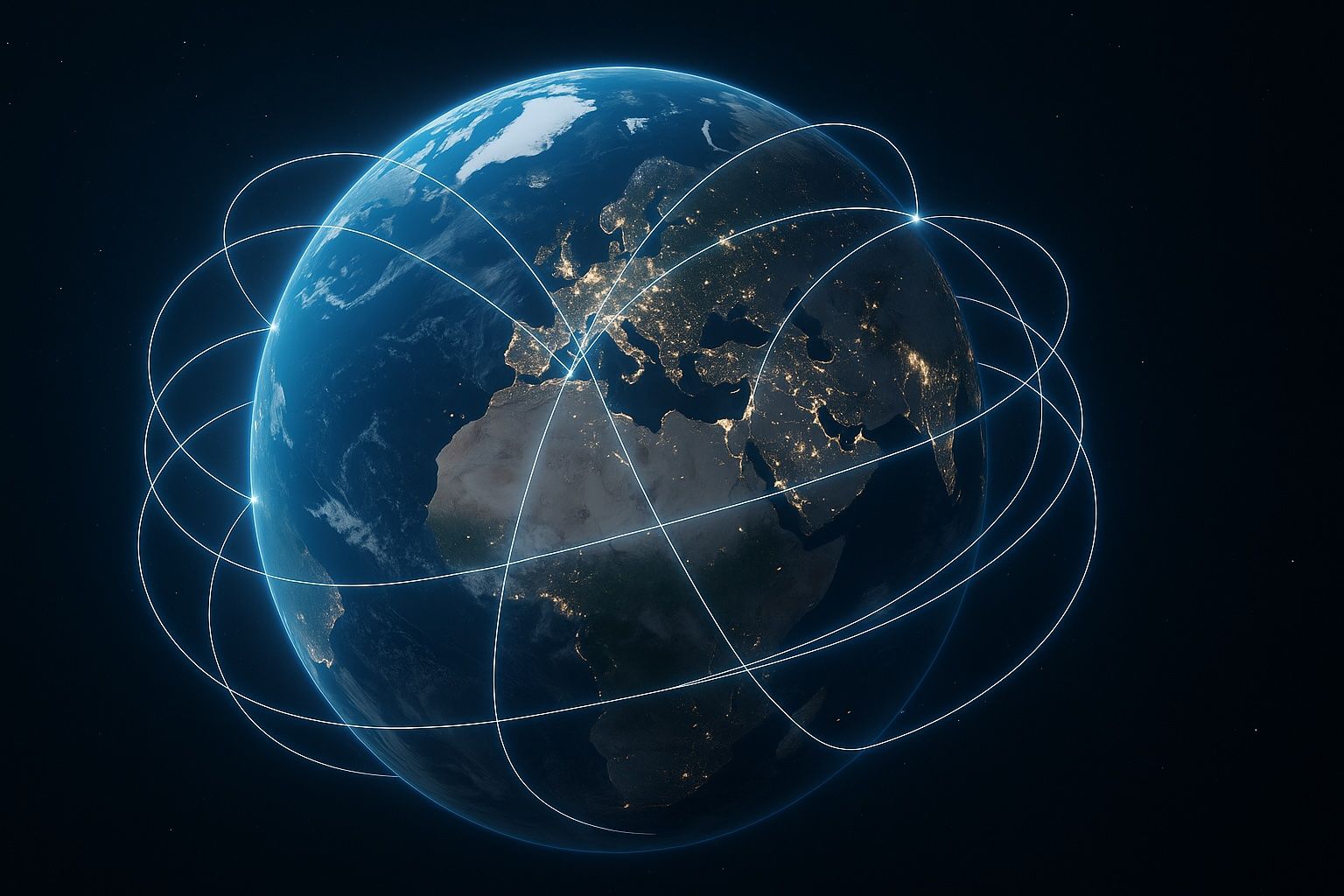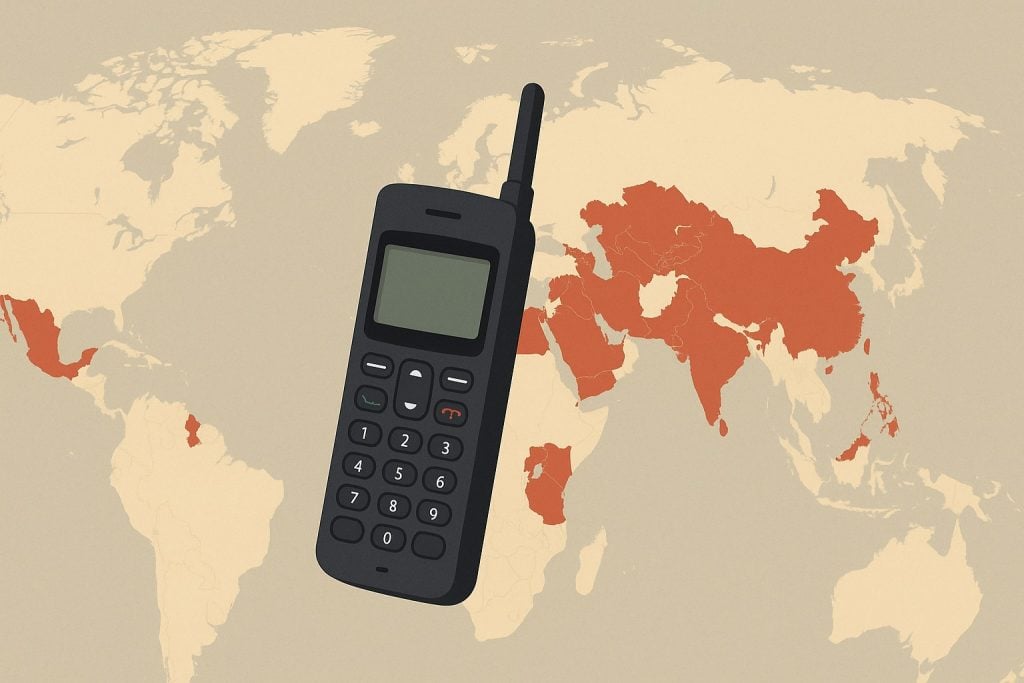- Sputnik 1, launched by the Soviet Union on October 4, 1957, was the first artificial satellite.
- Explorer 1 became the United States’ first satellite in 1958.
- As of 2025, there are roughly 11,000+ active satellites orbiting Earth, with tens of thousands of pieces of inactive satellites and debris.
- Geostationary satellites orbit about 35,786 km (22,236 miles) above the equator and stay fixed over one ground spot.
- Most satellites use solar panels with large arrays and rechargeable batteries to power their instruments and systems, including during eclipses.
- The first known accidental collision of two satellites occurred in 2009.
- Starlink is SpaceX’s constellation of thousands of small satellites in low Earth orbit, a few hundred miles up, designed to provide global internet with lower latency, and as of 2025 it accounts for a large share of active satellites.
- Geostationary satellite internet has about 600 milliseconds round-trip latency, while newer low-Earth-orbit networks reduce latency.
- The Emergency SOS via satellite feature on iPhone 14 and newer allows sending emergency texts when there is no cell network by guiding the user to point at a satellite.
- A satellite phone is a dedicated device that communicates directly with satellites for calls and texts, whereas the iPhone’s satellite SOS is emergency-only and not for everyday communication.
Satellites are objects that orbit a larger body, like Earth or another planet [1]. They play many roles in modern life, from beaming TV signals and providing internet/phone connections to monitoring weather and enabling GPS navigation [2] [3]. Below is an extensive FAQ, grouped by topic, answering common questions about satellites and related technologies in simple terms.
General Satellite Basics
- What is a satellite? / What does a satellite do?
A satellite is any object that orbits a planet or star [4]. Natural satellites include moons (for example, the Moon is Earth’s satellite), while usually “satellite” refers to artificial (man-made) machines launched into space to circle Earth or another body [5]. These satellites do many jobs like communication, Earth observation, and navigation – for instance, relaying TV signals, taking pictures of Earth for weather forecasting, or enabling GPS location services [6] [7]. - What are the types of satellites (natural vs. artificial)?
Natural satellites are celestial bodies that orbit a planet naturally, such as the Moon orbiting Earth. Artificial satellites are human-made objects sent into orbit (like the International Space Station or weather satellites) [8]. In short, moons and some planets are natural satellites, whereas communications, GPS, or scientific satellites are artificial. - How do satellites stay in orbit (why don’t they fall down)?
Satellites stay in orbit by moving very fast sideways, so that the pull of Earth’s gravity is balanced by their orbital speed [9]. Basically, they are falling toward Earth due to gravity but moving forward so quickly that they keep missing it – thus they continuously fall around Earth rather than down to it. If a satellite slows down too much, gravity will pull it back and it would re-enter the atmosphere. - Why don’t satellites crash into each other in space?
Generally, satellites are launched into carefully planned orbits to avoid collisions. Space is enormous, and different satellites operate at different altitudes and paths. While collisions are very rare, they can happen – the first known accidental collision of two satellites occurred in 2009 [10]. To minimize risk, organizations track satellites and debris, and as orbit traffic increases, collision avoidance maneuvers are sometimes used. - How many satellites are in space right now?
There are thousands of human-made satellites orbiting Earth. As of 2025, roughly 11,000+ active satellites are in orbit around Earth (not counting space junk) [11]. This number has been growing rapidly with the launch of many new satellites (especially large networks like Starlink). Additionally, there are tens of thousands of pieces of inactive satellites and debris also floating in orbit. - What was the first satellite in space?
The first artificial satellite ever launched was Sputnik 1, sent into orbit by the Soviet Union on October 4, 1957 [12]. Sputnik 1 was a small metallic sphere with radio transmitters, and its successful launch marked the start of the space age. (For reference, the first U.S. satellite was Explorer 1 in 1958 [13].) - Why are satellites important to us? / What are satellites used for?
Satellites have become essential because they allow us to do things that would be impossible or harder from the ground. They enable worldwide communications (beaming TV, phone, and internet signals across long distances), help us navigate (via GPS satellites that pinpoint your location) [14], monitor Earth’s weather and climate (seeing cloud patterns, storms, and environmental changes), and conduct scientific observation of space (telescopes in orbit can observe stars and galaxies without atmospheric distortion) [15]. In short, many everyday services – from watching live sports on TV to getting directions on your phone – rely on satellites. - What is a geostationary satellite?
A geostationary satellite is one that orbits Earth above the equator at the same rate that Earth rotates, effectively staying fixed over one spot on the ground [16]. These satellites are very high up (around 35,786 km or 22,236 miles above Earth). Because they match Earth’s rotation, an antenna on the ground can point at the same spot in the sky and continuously communicate with that satellite (this is how satellite TV dishes remain pointed at one position). Geostationary satellites are commonly used for communications and weather observation. - How do satellites get power to run?
Most satellites use solar panels to generate electricity from sunlight [17]. They have large solar arrays that convert sunlight into power to run their onboard instruments, computers, and communication systems. They also carry rechargeable batteries to keep the satellite powered when it passes through Earth’s shadow (eclipse), where sunlight is blocked. - Do satellites eventually stop working? What happens then?
Yes, satellites have limited lifespans (due to fuel depletion or equipment wear-out). When a satellite stops working, operators will often move it to a “graveyard orbit” (if it’s in high orbit) or let it fall back into the atmosphere to burn up safely. Smaller satellites in low Earth orbit will gradually lose altitude and incinerate during re-entry after a few years or decades once they die, helping to prevent long-term space debris.
Satellite Phones and Communication
- What is a satellite phone? / How do satellite phones work?
A satellite phone (or “sat phone”) is a mobile telephone that connects directly to satellites in space instead of using cell towers [18]. This means it can make calls (and often send texts or data) from virtually anywhere on Earth, even in the middle of oceans or remote deserts, as long as it has a line-of-sight to the satellite. Sat phones work by transmitting your voice or message as radio waves to a communication satellite overhead, which then relays it down to a ground station and into the regular phone network. They are commonly used by travelers, emergency responders, or organizations in areas with no reliable cellular coverage. - Who uses satellite phones?
Satellite phones are used by people who need connectivity in places without regular cell service. This includes explorers, sailors, hikers in remote wilderness, journalists or researchers in remote regions, and military or rescue teams [19]. They provide a critical lifeline for emergency communication in disaster zones or off-grid locations. (Everyday consumers generally don’t use sat phones unless needed, since they tend to be more expensive to buy and operate than normal mobile phones.) - Are satellite phones legal to use and do they cost more?
In most countries, satellite phones are legal, but a few nations restrict or require registration for their use (due to security concerns). Using a sat phone is typically more expensive than a regular cell phone: the devices often cost more, and calls are pricier (you might pay a few dollars per minute, depending on the service). You also usually need a subscription plan or prepaid credits from a satellite phone provider. However, costs have been coming down and short emergency-use plans are available. Always check local regulations before using a sat phone in a foreign country. - What is satellite communication?
Satellite communication refers to any communication link that involves the use of an artificial satellite to relay signals. Essentially, a satellite in space acts as a relay station: it receives radio signals transmitted from an Earth station (like a ground antenna) and then rebroadcasts them to another ground station somewhere else on Earth [20]. This technology allows data, voice, or video to be transmitted over huge distances – even to the other side of the globe – instantaneously. Satellite communication is the backbone of services like satellite TV, international phone calls in remote areas, satellite internet, and even some military communications.
Satellite Internet
- What is satellite internet? / How does satellite internet work?
Satellite internet is a way to access the internet using signals transmitted by satellites orbiting the Earth instead of land-based cables or cell towers. In this system, your home or business has a satellite dish antenna that both sends and receives data to a satellite in space [21]. Here’s how it works: when you browse or send something, your modem sends data through the dish up to a satellite; the satellite relays it down to a ground station connected to the internet backbone, and then the process reverses to send data back to you [22]. Because it’s wireless from space, satellite internet can provide coverage virtually anywhere (even rural or remote areas where other internet options aren’t available) [23]. However, traditional satellite internet can have higher latency (delay) because of the long distance the signals travel. - Is satellite internet slow? What are the downsides?
Modern satellite internet can offer broadband speeds, but there are a few downsides. The distance to geostationary satellites (around 36,000 km up) causes noticeable latency (maybe ~600 milliseconds or more round-trip), which can make online gaming or real-time video calls laggy. Weather (heavy rain or storms) can sometimes disrupt the signal between your dish and the satellite, affecting the connection. Also, many satellite internet plans had data caps or lower data allowances compared to cable/fiber. Newer low-Earth orbit satellite constellations (like Starlink) are reducing latency and increasing speeds, improving performance significantly, though they require many more satellites overhead. - Where is satellite internet used?
Satellite internet is often used in rural or remote regions where DSL, cable, or fiber internet is not available. This includes countryside homes, ships at sea, airlines (in-flight Wi-Fi often uses satellites), or field research stations. Essentially, any place outside the reach of ground-based communication networks can use satellite internet to get online. It’s also used as backup connectivity for critical operations (like hospitals or businesses) in case terrestrial networks go down. - What is Starlink?
Starlink is a satellite internet constellation operated by SpaceX (Elon Musk’s company) that aims to provide high-speed, low-latency internet service globally. Unlike traditional satellite internet which uses a few big satellites far from Earth, Starlink uses thousands of small satellites in low Earth orbit (only a few hundred miles up) [24]. This network of satellites works together to blanket the planet in coverage, so wherever you are, at least one (and usually several) Starlink satellites are overhead to beam internet to you via a special dish antenna. Starlink’s closer distance to Earth means much lower latency, and it can support activities like streaming, online gaming, and video calls more smoothly [25]. (As of 2025, Starlink already makes up a large share of all active satellites in orbit, and the service continues to expand.) - How do I get satellite internet?
To get satellite internet, you subscribe to a satellite internet provider who offers service in your area. They will provide and usually install a satellite dish (antenna) on your property with a clear view of the sky, plus a special modem/router. The dish is pointed at the provider’s satellite in orbit. Once set up, your computers and Wi-Fi devices connect to the modem like any internet service. Well-known providers include HughesNet and Viasat for geostationary satellite internet, and Starlink for the new LEO satellite service. Keep in mind you’ll need power for the equipment and a mounting location where the dish can “see” the satellite (no obstructing trees or buildings).
Satellite TV and Radio
- What is satellite TV? / How does satellite television work?
Satellite TV is a television service delivered to viewers via communications satellites in space [26]. With satellite TV, broadcast signals are sent from a TV station to a satellite, and then the satellite beams those signals down to a subscriber’s satellite dish at their home. Here’s how it works: a small dish antenna on your house is aimed at a particular satellite in geostationary orbit; the satellite transmits TV channels to the dish, and a receiver box connected to the dish decodes those signals and sends the picture to your television [27]. Because the satellite is high above Earth, satellite TV can reach remote or rural areas just as easily as cities (as long as the dish can see the satellite in the sky). Millions of people use satellite TV (from providers like DirecTV or Dish Network) to get a wide range of channels, especially where cable TV isn’t available. - What is a satellite dish?
A satellite dish is a specialized antenna shaped like a bowl (parabolic dish) that is designed to receive (or sometimes transmit) signals to and from a satellite. The dish’s curved shape focuses incoming radio signals onto a feed horn in front of it, which then passes the signal to the receiver equipment [28]. In simpler terms, the dish “collects” the weak signal from a distant satellite and concentrates it so it can be decoded into TV, internet, or phone data. Satellite dishes can often be seen on rooftops or sides of homes (for TV or internet), and they need a clear line of sight to the satellite. There are many sizes of dishes – small ones for direct-to-home TV, and much larger ones for satellite ground stations or old C-band networks. - What is satellite radio?
Satellite radio is a broadcasting service where radio channels are transmitted by satellites rather than local radio towers. In practice, it means you can receive a wide range of radio stations over a much broader area (often an entire country or continent) with a special satellite radio receiver [29]. Services like Sirius XM in North America broadcast digital radio signals from their satellites down to subscribers’ receivers (commonly in cars). Satellite radio usually requires a paid subscription, but in return you get many channels including music, talk, sports, etc., that are mostly static-free and available virtually anywhere (from cities to highways in the middle of nowhere). It’s especially popular for drivers and truckers because the signal covers long distances uninterrupted. The radio receiver’s antenna (often a small dome or shark-fin shape on a car) picks up the satellite signal, and the receiver decodes it into audio. Aside from needing the proper equipment and subscription, using satellite radio is as easy as tuning channels like regular radio.
Smartphones and Satellite Features
- What does “satellite” mean on iPhone? / Why does my iPhone say “SOS” or “Satellite”?
Newer iPhone models (starting with iPhone 14) have an Emergency SOS via satellite feature. If you see a “Satellite” or “SOS” icon on your iPhone, it means your phone can’t find a cellular or Wi-Fi network, but it’s indicating that you could connect to a satellite for emergency services. In emergency SOS mode, the iPhone can send a text message to emergency responders via satellite if you’re off the grid. Essentially, the phone will guide you to point it at an overhead satellite to send an SOS message. So, “satellite” on the iPhone means the device is ready to use a satellite link to get help, as a last resort when no regular signal is available [30]. (Don’t worry – it’s not constantly using satellites; it only activates if you initiate an emergency SOS or use a satellite-specific feature.) - Can my smartphone connect to satellites for regular use (calls or texts)?
Generally, today’s mainstream smartphones (aside from emergency SOS features) do not act as full satellite phones. The built-in satellite function in phones like the iPhone 14 is limited to emergency texting and location sharing, not normal voice calls or browsing. However, technology is evolving: some companies are working on satellites that could directly route regular text messages to ordinary phones in the near future. For now, if you want true satellite communication for calls or continuous texting, you would need a dedicated satellite phone or a special satellite hotspot device. - What’s the difference between a satellite phone and an iPhone with SOS via satellite?
A satellite phone is built to communicate directly with satellites for all calls and messages, anytime. It works independently of cellular networks. The iPhone’s SOS via satellite is a limited emergency feature – it only allows you to send critical text messages (and share location) when you have no cell signal, and it’s intended for emergencies. The iPhone uses satellite only for these specific functions and not for everyday phone calls or internet use. Also, using the iPhone’s satellite SOS requires you to be outside with a clear view of the sky and follows a guided process to point at a satellite, whereas a satellite phone has a dedicated antenna and is made for more regular satellite communication.
Other Uses of the Term “Satellite”
- What is a satellite office?
A satellite office is a smaller branch office that a company opens in a different location from its main headquarters [31]. It’s essentially a secondary office meant to extend the company’s presence to another region. For example, a tech company based in New York might have a satellite office in San Francisco. These offices often have fewer employees and are set up to tap local talent, serve local customers, or reduce overcrowding at HQ. In short, a satellite office is like a “mini HQ” in another location, helping teams work closer to a certain area without having to be at the main office. - What does the term “satellite campus” mean?
A satellite campus refers to a smaller campus or facility of a college/university (or even a school) that is physically separate from the institution’s main campus. Like a satellite office, a satellite campus is a branch location – for instance, a university might have its main campus in one city and a satellite campus in another city to serve more students or specific programs. Students at a satellite campus can attend classes and use services without traveling to the main campus, while still being part of the same school. - Why is the term “satellite” used in these contexts (office, campus, etc.)?
In these cases, “satellite” is used as a metaphor. Just as a real satellite orbits a planet, a “satellite office” or “satellite campus” orbits around the main hub of activity (the headquarters or main campus). It indicates they are secondary or support locations connected to a central entity. The word suggests being off-site yet still linked organizationally – much like a satellite in space is separate but still connected to Earth in function.
References
1. spaceplace.nasa.gov, 2. spaceplace.nasa.gov, 3. spaceplace.nasa.gov, 4. spaceplace.nasa.gov, 5. spaceplace.nasa.gov, 6. spaceplace.nasa.gov, 7. spaceplace.nasa.gov, 8. spaceplace.nasa.gov, 9. spaceplace.nasa.gov, 10. spaceplace.nasa.gov, 11. www.livescience.com, 12. en.wikipedia.org, 13. spaceplace.nasa.gov, 14. spaceplace.nasa.gov, 15. spaceplace.nasa.gov, 16. spaceplace.nasa.gov, 17. spaceplace.nasa.gov, 18. www.satelliteinternet.com, 19. www.satelliteinternet.com, 20. www.hytera.com, 21. www.satelliteinternet.com, 22. www.satelliteinternet.com, 23. www.satelliteinternet.com, 24. www.business-standard.com, 25. www.business-standard.com, 26. www.directv.com, 27. www.directv.com, 28. electronics.howstuffworks.com, 29. en.wikipedia.org, 30. www.satelliteinternet.com, 31. www.indeed.com










